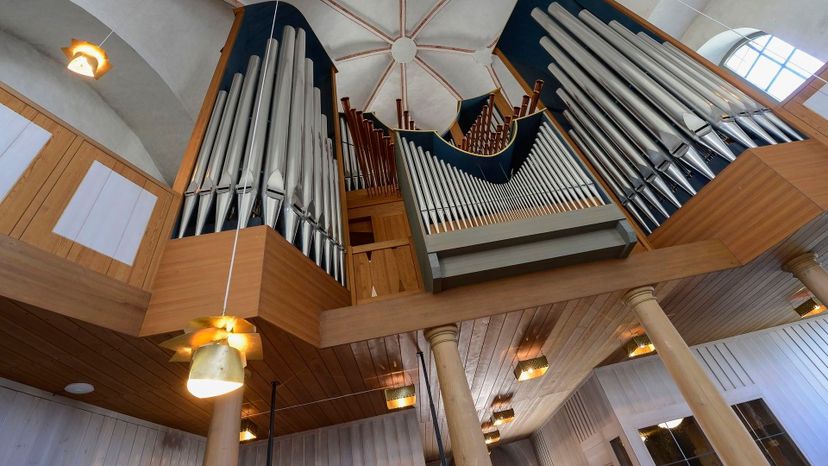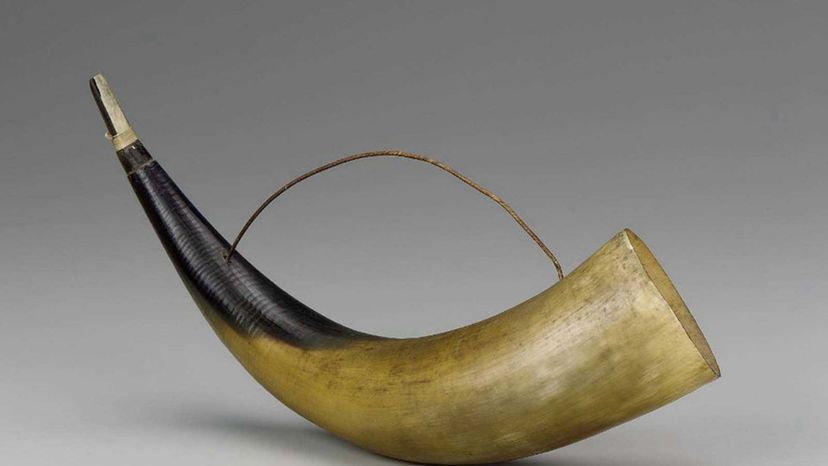
About This Quiz
Come get blown away! Here is a chance to show how much you know about woodwind instruments - you might find there are a few intriguing ones you never knew existed!
All woodwind instruments have certain features in common, but they are also different in many ways. Take their size, for instance - they range from very small to almost gargantuan! Furthermore, while they all use air to make music, not all of them are played by blowing with your mouth.
As a group of instruments, woodwinds began very simply, quite often made from hollow sticks or animal bones. Some of these traditional instruments have changed very little over thousands of years and are still used in folk music in various regions of the world. They retain their rustic design and continue to stand out with the unique melodies they can play.
A fine example is that woodwind instrument made from animal skin and often associated with the kilt-wearing men of the Highlands. Can you name that one? It's one of the instruments in the quiz, so jump right in and have a go at it!
Come prove you are not just a blowhard when it comes to musical instruments. Ace this quiz and toot your own horn with pride!

The bass clarinet looks very much like a saxophone, thanks to its curved neck at the top and curved bell at the bottom. Bass clarinets measure more than 40 inches in length.

This small flute's name refers to its size - "piccolo†is Italian for "small.†The high pitched sound of the piccolo is often compared to a bird call.

The modern pipe organ has its root in an instrument known as a water organ (also called a hydraulic organ or hydraulos), which was used in Ancient Greece around 3 B.C.E. Established use of organs in churches did not begin until around the 9th century, and the modern pipe organ did not actually appear until the 16th century.
Advertisement

In some countries, the melodica is commonly used for the same purpose as the recorder - to teach children who are learning to play their first musical instrument. The melodica goes by several names, some of which are based on its appearance, including pianica, face piano and key harmonica.

The C flute is also known as the standard or Western concert flute. Someone who plays the flute may be called a flutist, flautist, flutenist, flute player or fluter.

The oboe was first developed in the 1600s, at which time it was known by the French name "hautbois.†It is related in form to the shawm, another type of woodwind instrument.
Advertisement

It is not unusual for some people to mistakenly call the bassoon an oboe. The two are related and have a similar appearance, plus, to complicate things even further, the bassoonist and the oboist tend to sit close by each other in an orchestra.

The saxophone is named after its creator, Belgian musician Adolphe Sax. There are 14 members to the saxophone family he invented in 1840 but only four of these are popularly used nowadays: the soprano, tenor, alto and baritone saxophones.

Despite its name, the English horn is not a horn at all but actually belongs to the oboe family of instruments. Furthermore, it originated in Central Europe, not England as the name suggests.
Advertisement

The recorder dates back to the end of the Middle Ages, with the earliest evidence placing it in 14th-century Europe. That makes the recorder older than the tuba, clarinet and harmonica.

The xaphoon was invented by Hawaiian saxophonist Brian Wittman in 1972. The original instrument was made out of bamboo and created to sound like a saxophone but be much easier to play. It is often referred to as the pocket sax.

The fife is similar in appearance to both the recorder and the piccolo. Like the piccolo, it is played from the side by blowing into (but not touching) the mouthpiece, but instead of the levers found on a piccolo, the fife has finger holes like the recorder.
Advertisement

Out of the 14 saxophones invented by Belgian musician Adolphe Sax in 1840, there are only two which are smaller than the soprano saxophone. These are the sopranissimo and sopranino saxophones.

Although typically associated with Scottish culture, the bagpipes can be found as a traditional instrument throughout Europe, the Persian Gulf, North Africa and western Asia. It was most often made using a whole animal skin (usually sheep), but today synthetic materials are often used.

The bombard is a member of the shawm family of musical instruments and, as such, is closely related to the oboe. The bombard is quite popular as a traditional instrument in the Brittany region of northwest France, where it is often played alongside a bagpipe-type instrument.
Advertisement

The pan flute is easily recognized by its pipes, which usually increase in length from one end to the other. Even when the pipes are all the same length, they are stoppered at different points on the inside to give the desired variations in pitch. On some pan flutes, the pipes also have increasing width.

The sarrusophone was introduced in 1856 by Pierre-Louis Gautrot. It was once very popular as a band instrument and was, in fact, named after a French bandmaster: Pierre-Auguste Sarrus, who is said to have come up with the original design.

The crumhorn (or krummhorn) was a very popular instrument in the 15th to 16th centuries in Europe. Its name is derived from a Middle English word for "bent†and refers to its characteristic J-shaped body.
Advertisement

The bass flute is one of the more uncommon instruments in the flute family. When outstretched, the tube of the bass flute is almost five feet long. Another type, the hyperbass flute, has a tube which extends out to 49 feet

The word clarinet means "little trumpet," but the largest members of the clarinet family can have tubes over 10 feet long. Usually when anyone simply refers to a clarinet, it is the soprano clarinet that they have in mind.

The ocarina is described as a globular flute. Its body is enclosed and is made in several different shapes, including egg, horn, pendant, bird and spout. It is sometimes called a sweet potato pipe.
Advertisement

The accordion is also known as a squeezebox, thanks to its shape and the method of playing it. Playing the accordion requires you to press the keys with one hand while you compress or expand its bellows with the other hand.

The reclam de xeremies is a double-barreled, conjoined flute. Traditionally made with cane tubes, the reclam de xeremies originated on the island of Ibiza, located off Spain's eastern coast.

The tárogató looks very much like a soprano saxophone on the outside, but on the inside it has a narrower bore, and so it produces a different sound. It is a common folk instrument in both Romania and Hungary.
Advertisement

The tin whistle, like the recorder, is a type of fipple flute, meaning it has a narrowed mouthpiece. There is evidence of the use of instruments very similar to the tin whistle in various ancient cultures around the world, including the Ancient Greeks and Romans.

The sralai is a traditional instrument from Cambodia. It is similar in appearance to the oboe and is, in fact, often mistakenly called an oboe by people who are not familiar with it.

The contrabassoon is often identified as the lowest pitched instrument in an orchestra. It is also known as a double bassoon.
Advertisement

The hornpipe has been around for centuries and is still fairly common in regions of Russia, Spain, North Africa and the Arabian Peninsula. There are also several hornpipe dances which were created to be performed to the music of a hornpipe.

The shakuhachi is a traditional Japanese bamboo flute, based on an earlier Chinese instrument. It is currently made in various lengths, but it was originally a set length, roughly equivalent to 21.5 inches, which was called a shakuhachi - hence the name of the instrument.

The harmonica was invented in Europe, sometime in the 19th century. It has become popular worldwide and is often associated with blues music created by African Americans in the southern U.S. Other names used for the harmonica include mouth organ and French harp.
Advertisement

The bass saxophone is one of the largest members of the saxophone family. Only the contrabass and subcontrabass saxophones are bigger, but they are even rarer to come across than the bass saxophone.

The pku, or pzuk, is a traditional Armenian instrument. It has a seven-hole design with a bull horn at the non-blowing end.

This South American folk musical instrument can be found in regions of Bolivia, Peru and Argentina. Its sound is most often compared to a moaning animal.
Advertisement

The suona is a traditional Chinese instrument related to the shawm. It originated in Arabia, but since the 16th century it has become quite popular in China, especially in the northern regions of the country.

The Italian piffero is related to both the shawm and the bombard. It is usually played alongside the accordion and a type of bagpipe known as the müsa appenninica.

The modern version of shepherd's shawm, or hirtenschalmei, is made based on images and mention of the instrument found in medieval French literature. There is also one example of an actual shepherd's shawm that was found in 1980 in a sunken shipwreck from 1545.
Advertisement

As its name suggests, the oboe d'amore is a member of the oboe family. It is larger than a regular oboe and not as common. Famed German composer Johann Sebastian Bach included music for the oboe d'amore in several of his compositions.

The pibgorn is associated with Welsh folk music, particularly the music of shepherds and cattle drovers. It is constructed from two bull horns joined by a wooden pipe.

The oboe da caccia (or hunting oboe) is very similar to a curved English horn. It was developed in Germany and dates back to at least the Baroque Period in the early 1700s.
Advertisement
